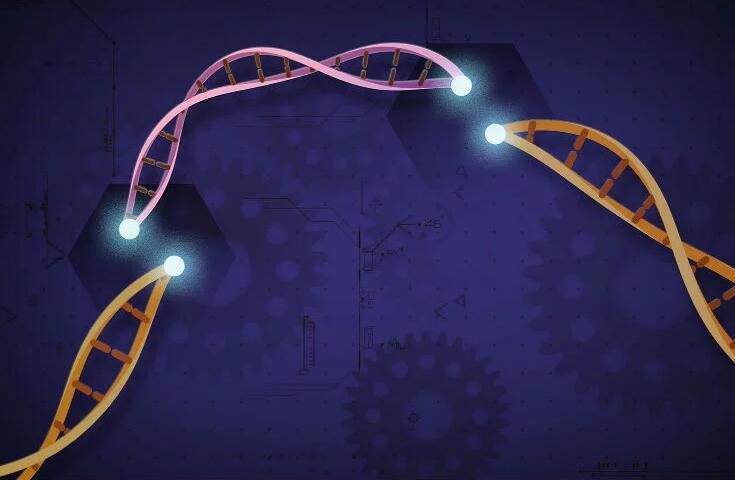As far as experts are concerned, the technology of gene editing is nowhere near ready to be used to create gene-edited babies.
就專家而言,基因編輯技術(shù)還遠(yuǎn)不足以被用于創(chuàng)造基因編輯嬰兒。
This, of course, is separate from the question of whether it is morally right to do so.
當(dāng)然,這要和道德正確性的問題區(qū)分開來。
Nevertheless, around the world, would-be baby tinkerers have failed to get the memo.
但在世界各地,想成為嬰兒工匠的人并沒有獲得諒解備忘錄。
This week a Russian scientist announced his ambition to repeat a Chinese scientist's gene-editing experiment on human embryos,
本周,一名俄羅斯科學(xué)家宣布了他重復(fù)中國科學(xué)家基因編輯人類胚胎實(shí)驗(yàn)的雄心,
which lead to the birth of two babies with modified ccr5 genes last year.
去年在該中國科學(xué)家的實(shí)驗(yàn)中,兩名攜帶修改ccr5基因的嬰兒出生。
The Chinese effort was roundly condemned on grounds of safety and ethics.
出于安全和道德因素,這名中國科學(xué)家的努力遭到譴責(zé)。
Moreover, at the start of June evidence emerged that the genetic mutation in the gene CCR5,
而且在六月初,有證據(jù)表明CCR5基因中的基因突變
one that offers protection against infection from HIV, is also associated with slightly earlier death.
一種預(yù)防HIV感染的基因,也和早逝有些關(guān)聯(lián)。
The finding highlights the need to understand far more about how alterations in a cell's DNA translate into changes in how it functions.
這一發(fā)現(xiàn)強(qiáng)調(diào),我們有必要進(jìn)一步了解細(xì)胞DNA 的變化如何轉(zhuǎn)化為細(xì)胞功能中的變化。
There are also a variety of concerns about the basic technology
人們對(duì)于這項(xiàng)基本技術(shù)也有各種各樣的擔(dān)憂

that need to be dealt with before it can be used widely in treatments for the sick—let alone to tinker with healthy embryonic humans.
在廣泛應(yīng)用于治療病人之前,需要解決這些擔(dān)憂—更不用說對(duì)健康的胚胎人類進(jìn)行修補(bǔ)了。
CRISPR-Cas genome-editing systems, often just known as CRISPR,
CRISPR-Cas基因編輯系統(tǒng),也常被稱為CRISPR
are molecular machines that can be programmed to home in on specific sections of DNA in the genome
是分子機(jī)器,可以通過編輯鎖定基因組中的特殊DNA部分,
and cut both strands of the double helix molecule. This system allows genes to be knocked out or, in some cases, added.
并切斷雙螺旋分子的兩條鏈。這一系統(tǒng)能讓基因被敲除或在一些情況下被添加。
It is not a perfect mechanism. One concern, for example,
它并不是一個(gè)完美的機(jī)制。例如,擔(dān)憂之一是
is that editing can alter DNA in places it isn't supposed to and that these "off-target" effects could trigger cancers.
編輯可以改變本應(yīng)不該被更改的DNA并且這些“偏離目標(biāo)”的效果可以引發(fā)癌癥。
A second worry is that the cell can fill gaps with random DNA when it is making repairs.
第二個(gè)擔(dān)憂是,當(dāng)細(xì)胞進(jìn)行修復(fù)時(shí),它可以用隨機(jī)DNA填補(bǔ)缺口。
These could silence genes that the organism may need.
這可能會(huì)抑制生物體可能需要的基因。
A third concern is that although CRISPR successfully hunts down and cuts out faulty DNA,
第三個(gè)擔(dān)憂是,雖然CRISPR成功找到并切除了錯(cuò)誤的DNA,
it is harder to get it to insert the right new genes.
但要讓它嵌入正確的新基因更難。
Firms involved in developing CRISPR editing for use in medicines have downplayed concerns.
參與開發(fā)藥用CRISPR編輯的公司并沒有重視這些擔(dān)憂。
Perhaps that was inevitable as they depend on investors' optimism.
或許這是不可避免的,因?yàn)樗麄円蕾囉谕顿Y者的樂觀。
Rapid advances in many areas have supported the optimists' case that the gremlins in the new techniques can be overcome in time.
很多領(lǐng)域的迅速發(fā)展為這些樂觀者提供了支持—新技術(shù)中的搗蛋鬼遲早會(huì)被克服。
"Yesterday's problems are not necessarily tomorrow's," observes Helen O'Neill, a molecular geneticist at University College London.
“昨天的問題不一定會(huì)是明天的問題,”倫敦大學(xué)學(xué)院分子遺傳學(xué)家Helen O'Neill觀察道。
In that vein come two papers describing a way to improve CRISPR.
基于這種思路,兩篇論文描述了一種改進(jìn)CRISPR的方法。
The first from a team led by Feng Zhang of the Broad Institute in Cambridge, Massachusetts, was published on June 6th, in Science.
第一篇是由馬薩諸塞州坎布里奇博德研究所的張峰所領(lǐng)導(dǎo)的團(tuán)隊(duì)于6月6日發(fā)表于《科學(xué)》雜志上的。
The second comes this week in Nature from Samuel Sternberg's team at Columbia University in New York.
第二篇是本周由紐約哥倫比亞大學(xué) Samuel Sternberg的團(tuán)隊(duì)發(fā)表于《自然》雜志上的。
譯文由可可原創(chuàng),僅供學(xué)習(xí)交流使用,未經(jīng)許可請(qǐng)勿轉(zhuǎn)載。












